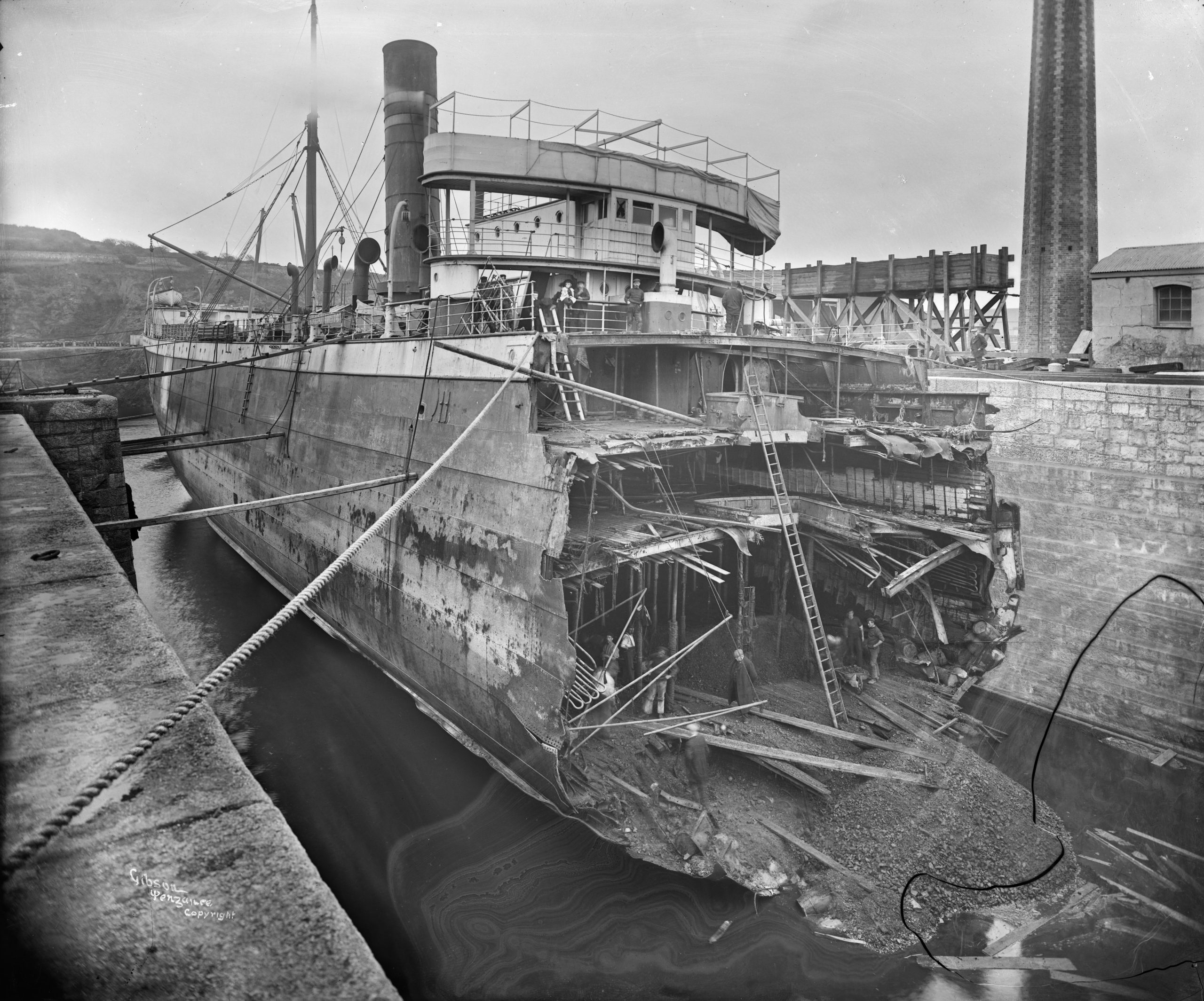The wreck of the Highland Fling: tragedy and ballast at sea
paul blickle

Port side view of ‘Highland Fling’ (1889), from the break in the hull, looking aft along dock. People can be seen in the cross-section of the hull. Credit line: © National Maritime Museum, Greenwich, London, Gibson’s of Scilly Shipwreck Collection Object: G14156 Artist: Gibson’s of Scilly Shipwreck Collection Date: unknown Medium: glass negative Size: 254 mm x 305 mm
This photograph of a shattered hull hides a rare sight. It is not the shipwreck.
The ship in question is the British steamer Highland Fling and the picture was taken at the Falmouth drydocks early in 1907.[1] A terrible disaster has sundered the ship in half, and all that remains is an almost anatomical cross-section of the ship. Labourers are interrupting their work to pose for the photographer. They are in the process of clearing ballast from the ship’s hold before its engines and parts can be salvaged and the rest of the Highland Fling scrapped.
The Highland Fling had been a mighty ship, almost a hundred metres long, first launched 17 years previously from a Newcastle shipyard. The ship boasted a modern steel hull and was fitted with electric lights as well as refrigeration machinery (the purpose of which remains obscure). Originally named the Duke of Portland and later the Morayshire, the steamer became the Highland Fling around 1905, when it joined the fleet of the Nelson Line of Liverpool (which christened all their ships with names beginning in ‘Highland’). The new owners employed the Highland Fling for trade with South America.[2] It was on one such voyage that disaster struck.
According to the London Times, the steamer ran aground near the Cornish coast in thick fog on the night of 7 January 1907. It had left London only days before carrying several thousand barrels of cement to Buenos Aires. An inquest by the Liverpool Board of Trade later ruled that the ship had exceeded safe speed too near the coast. The ship’s master, a Captain Purvis, was held responsible for this navigational error and his captain’s licence was suspended for a year. This was a light punishment, given that the newspapers valued the Highland Fling at £25,000 (nearly £3.2 million today), excluding the value of its cargo. At least, no loss of life was reported, and the vessel was sufficiently insured.
On 10 January, the Times reported a first, unsuccessful attempt to tow the steamer from the rocks after several hundred tons of cargo had been jettisoned. A second attempt, undertaken two days later, also failed and left the bow section of the vessel badly damaged. After repeated attempts to free the Highland Fling had proved futile, the London Salvage Association tried to retrieve at least part of the cargo and the ship’s most valuable parts (its engine and refrigeration machinery, which were located in the rear). Engineers planted dynamite along the hull with the aim to separate bow from stern by force, but heavy waves interrupted this plan. After being stuck on the rocks for two weeks, the sea finally achieved what the engineers had failed to do and smashed the ship in half, after which the rear was towed by tugboats to the nearby port of Falmouth. The bow section of the Highland Fling was left on the rocks, until it was smashed into oblivion by a storm on the night of 23 January.
At Falmouth the Highland Fling was documented in a series of dramatic photographs by the local studio of Gibson & Sons. The Gibsons ran a multigenerational business and hailed from the Scilly Isles — an island group southwest of Cornwall long associated with maritime disasters. Exactly 200 years before the calamity of the Highland Fling, another series of navigational errors had sunk four ships of the Royal Navy and killed 1500 sailors as well as an admiral on the cliffs of the Scillies. The disaster of 1707 famously sparked the eighteenth-century quest for more precise longitudinal measurements, and it was perhaps this piece of local history that had given the business’s founder, John Gibson (a sailor turned photographer in the 1860s), and his sons their taste for maritime tragedy. Pictures of the wrecked Highland Fling were probably taken by John’s son Herbert, who, over the course of his career, photographed countless ships in varying degrees of destruction.[4]

Port side view of ‘Highland Fling’ (1889), from the break in the hull, looking aft along dock. People can be seen in the cross-section of the hull. Credit line: © National Maritime Museum, Greenwich, London, Gibson’s of Scilly Shipwreck Collection Object: G14156 Artist: Gibson’s of Scilly Shipwreck Collection Date: uknown Medium: glass negative Size: 254 mm x 305 mm
Tragic as it was, the fate of the Highland Fling was by no means unusual. Surviving images of the shattered ship bear witness to the dangers of seafaring even at the dawn of the twentieth century. The dimensions of the remaining half of the hull are impressive, dwarfing the men labouring in its shadow, yet the advances of the industrial age were no match for the violence of wind and sea. Yet the apparent catastrophe of the shattered Highland Fling conceals something as mundane as it is invisible. Strewn across the lowest point of the hull lie sand and rocks, which the labourers are slowly removing by means of their shovels and wheelbarrows. These are not the remains of the cement cargo the ship was transporting to South America, which was packaged into barrels, some of which are still visible. What the labourers are removing is in fact the ship’s ballast.
The word ‘ballast’ is used almost exclusively as a metaphor today. But ballast was an integral part of seafaring. Its purpose was to lower a ship’s centre of gravity and to stabilise it at sea. This was done by loading cheap and heavy materials like sand, small stones and rubble into a ship’s hold, which lowered its waterline and reduced its tendency to pitch and roll. As ships travelled to the farthest corners of the globe, they carried ballast from and to ports all over the world. Ships needed the most ballast when they were running empty, but even fully loaded ships carried it. Especially during the winter months, shipmasters took care to load additional ballast. Looking at ships of similar size and displacement, the Highland Fling (which sailed in January) would have easily carried between 200 and 500 tonnes of sand and stones as ballast.[6]
Ballast was evidently necessary for safe travel at sea, but at the same time it routinely disrupted trade. Purchasing ballast and paying for the labour of loading and unloading it was a recurring expense, but what made ballast particularly vexing were the lengthy delays while ships waited to be ballasted. Shipping was a highly competitive industry in which the priority was to keep ships profitably at sea with cargo rather than wasting precious days in port. Waiting for ballast-men to load ballast after stevedores had unloaded cargo (or vice versa) considerably extended the time in port to the point where captains opted not to unload all their cargo rather than to wait for ballast. While global economic connections intensified, the necessity to carry ballast weakened and sometimes severed such connections.
As a mundane nautical component, ballast was deeply ingrained in the everyday practice of seamanship. As such, it is almost invisible in pictorial records. There are some depictions showing how it was loaded or unloaded, as well as a few anaemic photographs taken by archaeologists of ballast recovered from sunken ships. The images from Falmouth are a rare exception because they show ballast while it was in its proper place —in situ at the deepest point of a ship’s hold. This is important because whether any amount of sand and shingle counted as ballast or not was wholly determined by the nautical context: only their use at sea transformed sand and shingle into ballast. The very same materials could later be used to pave roads or build houses without a second thought given to their erstwhile nautical purpose.[7]
Another interesting aspect of the photographs is that the cross-section shows neither a double bottom nor double hull. Towards of the end of the nineteenth century, many ships had adopted double hulls, which made them more durable. The space in-between was waterproofed and used as a tank that could be filled with seawater. Water is less dense than sand and stone, but it is free and could be loaded and unloaded much more quickly. This solved some of the disconnective issues associated with solid ballast. Today, water ballast is used on almost every ship and has contributed significantly to the spread of invasive micro-organisms around the world.[8]
Not all water ballast was kept in double hulls. On board the Highland Fling, the water was most likely carried in large tanks located at the bow and stern of the ship and is therefore not visible in the cross-section. While it is often argued that solid ballast, like sand and stone, was quickly replaced by water, the images of the Highland Fling demonstrate the persistence of solid ballast. At the turn of the century, most steamers still used a mixture of water and solid ballasts, as well as the weight of their fuel, to stabilise the ship.[9]
The stranding of the Highland Fling might be a cautionary tale of navigational incompetence or the persisting dangers of maritime mobility a century ago. But what makes this image of tragedy exceptional is that it documents an otherwise almost invisible and forgotten aspect of seafaring.
[1] Gibson & Sons of Scilly, A View of the Stern Section at the Break in the Hull, of the Cargo Steamer Highland Fling (1890) in Drydock at Falmouth, c. 1907, Photograph, G14156, National Maritime Museum Greenwich, London, Gibson’s of Scilly Shipwreck Collection, https://www.rmg.co.uk/collections/objects/rmgc-object-1113561.
[2] Lloyd’s Register of British and Foreign Shipping. From 1st July, 1906, to the 30th June, 1907. Volume 1 – Steamers (London, 1906).
[3] ‘The Marine Insurance Market’, The Times (London), 9 January 1907, 13; ‘The Marine Insurance Market’, The Times (London), 10 January 1907, 13; ‘The Marine Insurance Market’, The Times (London), 14 January 1907, 15; ‘The Marine Insurance Market’, The Times (London), 15 January 1907, 15; ‘Shipping Disasters’, The Times (London), 21 January 1907, 9; ‘Wrecks, Casualties, &c.’, The Times (London), 24 January 1907, 10; ‘The Marine Insurance Market’, The Times (London), 4 March 1907, 14.
[4] John Fowles, Shipwreck, repr. ed. (London: Jonathan Cape, 1979).
[5] Gibson & Sons of Scilly, A View Directly into the Hull of the Cargo Steamer Highland Fling (1890), c. 1907, Photograph, G14155, National Maritime Museum Greenwich, London, Gibson’s of Scilly Shipwreck Collection, https://www.rmg.co.uk/collections/objects/rmgc-object-1113560.
[6] S. J. P. Thearle, ‘The Ballasting of Steamers for North Atlantic Voyages’, Transactions of the Royal Institution of Naval Architects 45 (1903): 118–33.
[7] Mats Burström, Ballast. Laden with History, trans. Charlotte Merton (Lund: Nordic Academic Press, 2017), 51–59.
[8] James T. Carlton, ‘Attack of the Invasive Species!’, in The Ocean Reader. History, Culture, Politics, ed. Eric Paul Roorda (Durham: Duke University Press, 2020), 473–82.
[9] B. Martell, ‘On Water Ballast’, Transactions of the Royal Institution of Naval Architects 18 (1877): 336–48.
bibliography
Burström, Mats. Ballast. Laden with History. Translated by Charlotte Merton. Lund: Nordic Academic Press, 2017.
Carlton, James T. ‘Attack of the Invasive Species!’ In The Ocean Reader. History, Culture, Politics, edited by Eric Paul Roorda, 473–82. Durham: Duke University Press, 2020.
Fowles, John. Shipwreck. Repr. ed. London: Jonathan Cape, 1979.
Gibson & Sons of Scilly. A View Directly into the Hull of the Cargo Steamer Highland Fling (1890). c. 1907. Photograph. G14155. National Maritime Museum Greenwich, London, Gibson’s of Scilly Shipwreck Collection. https://www.rmg.co.uk/collections/objects/rmgc-object-1113560.
———. A View of the Stern Section at the Break in the Hull, of the Cargo Steamer Highland Fling (1890) in Drydock at Falmouth. c. 1907. Photograph. G14156. National Maritime Museum Greenwich, London, Gibson’s of Scilly Shipwreck Collection. https://www.rmg.co.uk/collections/objects/rmgc-object-1113561.
Lloyd’s Register of British and Foreign Shipping. From 1st July, 1906, to the 30th June, 1907. Volume 1 – Steamers. London, 1906.
Martell, B. ‘On Water Ballast’. Transactions of the Royal Institution of Naval Architects 18 (1877): 336–48.
The Times (London). ‘Shipping Disasters’, 21 January 1907: 9.
The Times (London). ‘The Marine Insurance Market’, 9 January 1907: 13.
The Times (London). ‘The Marine Insurance Market’, 10 January 1907: 13.
The Times (London). ‘The Marine Insurance Market’, 14 January 1907: 15.
The Times (London). ‘The Marine Insurance Market’, 15 January 1907: 15.
The Times (London). ‘The Marine Insurance Market’, 4 March 1907: 14.
Thearle, S. J. P. ‘The Ballasting of Steamers for North Atlantic Voyages’. Transactions of the Royal Institution of Naval Architects 45 (1903): 118–33.
The Times (London). ‘Wrecks, Casualties, &c.’, 24 January 1907: 10.





